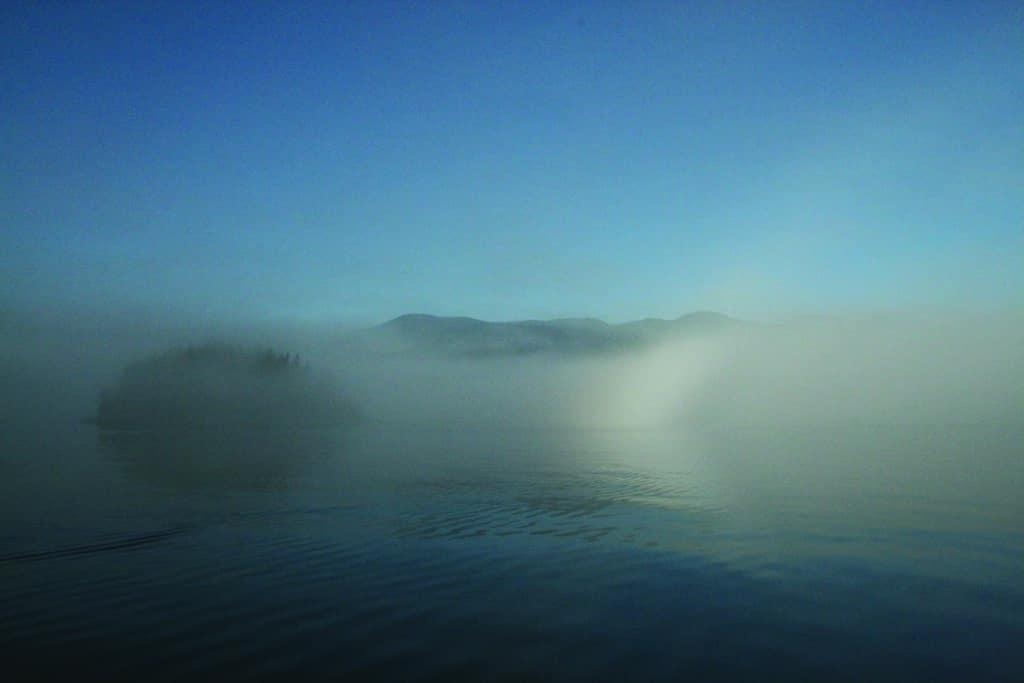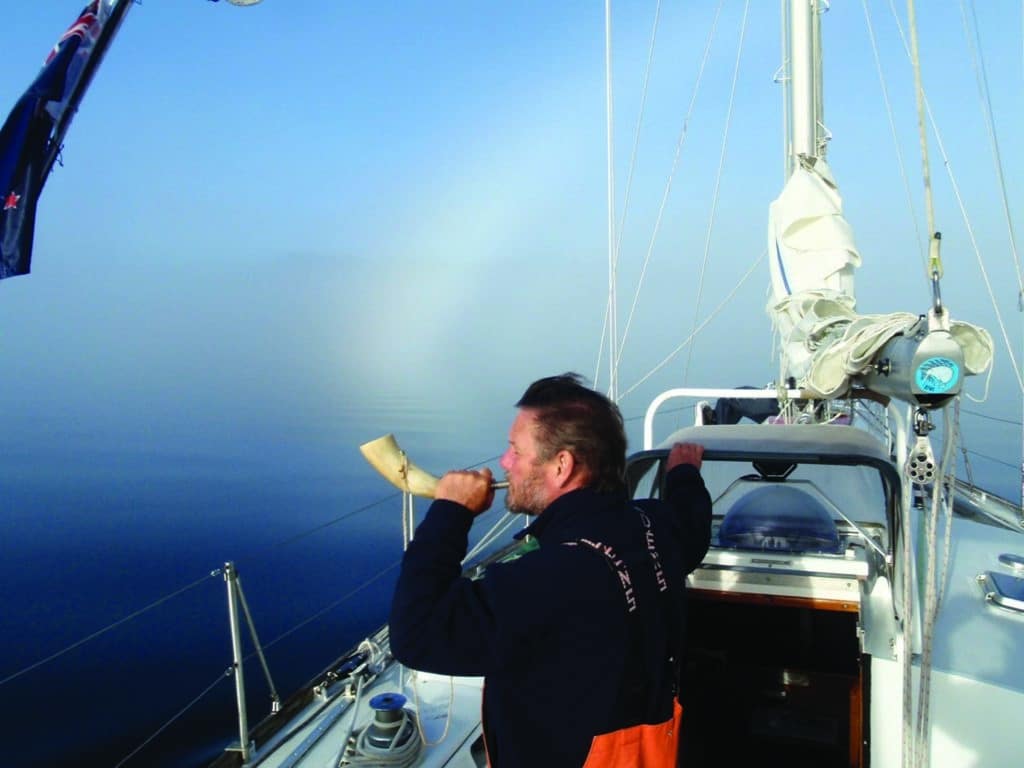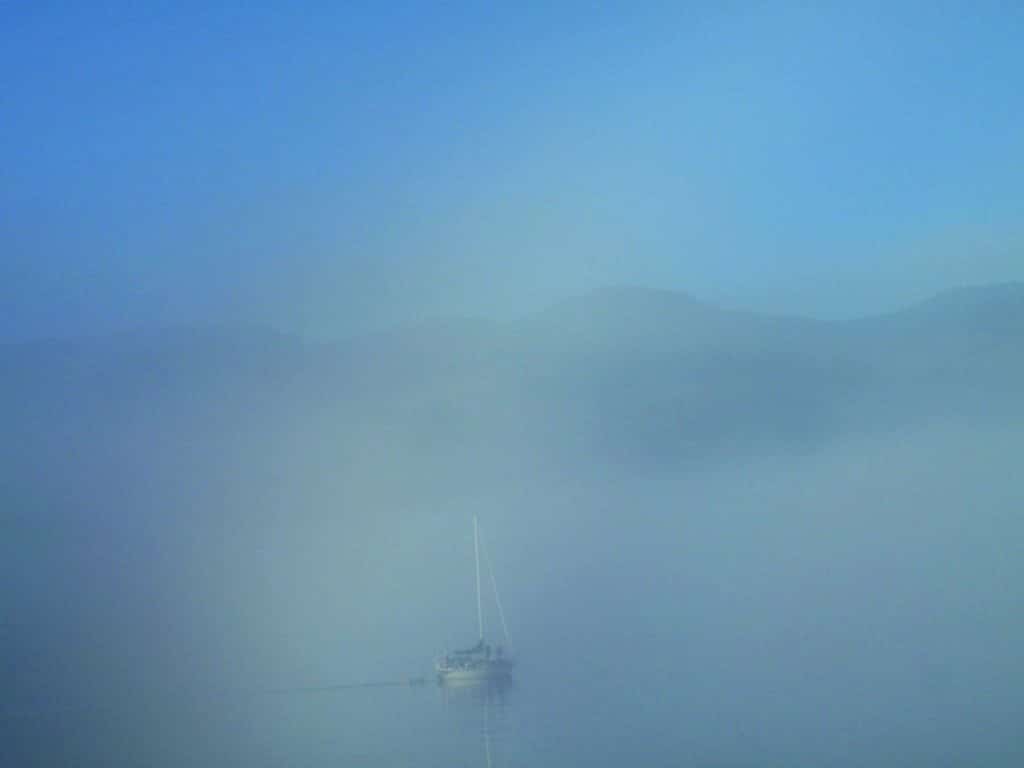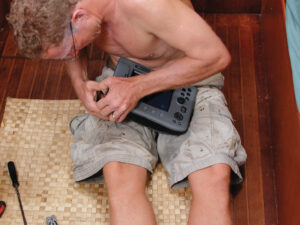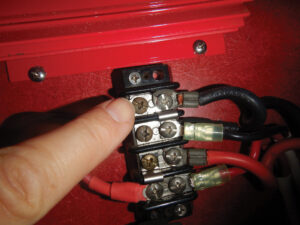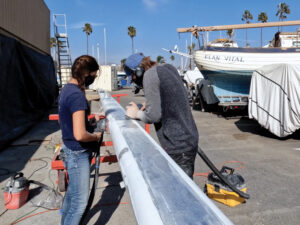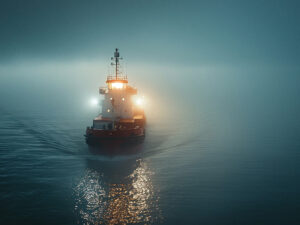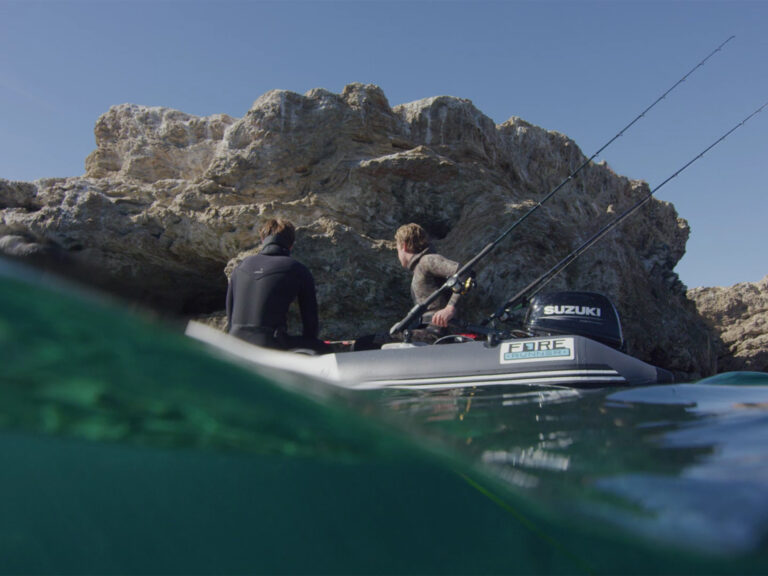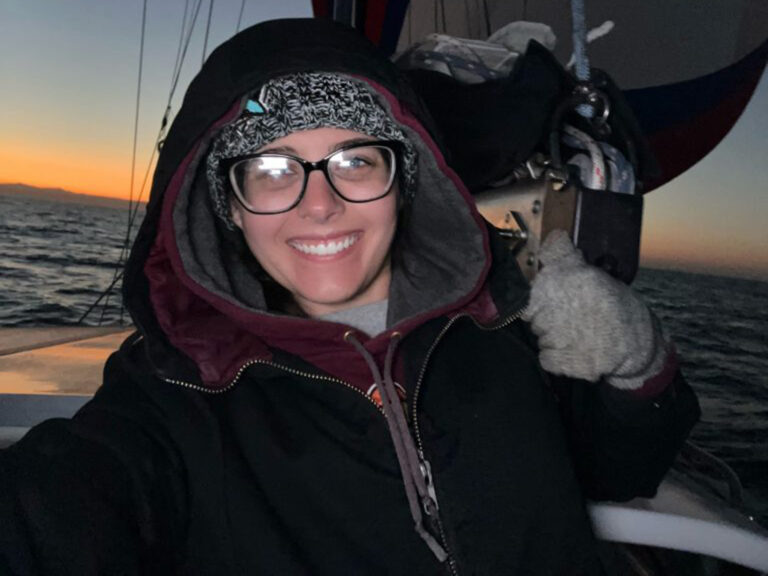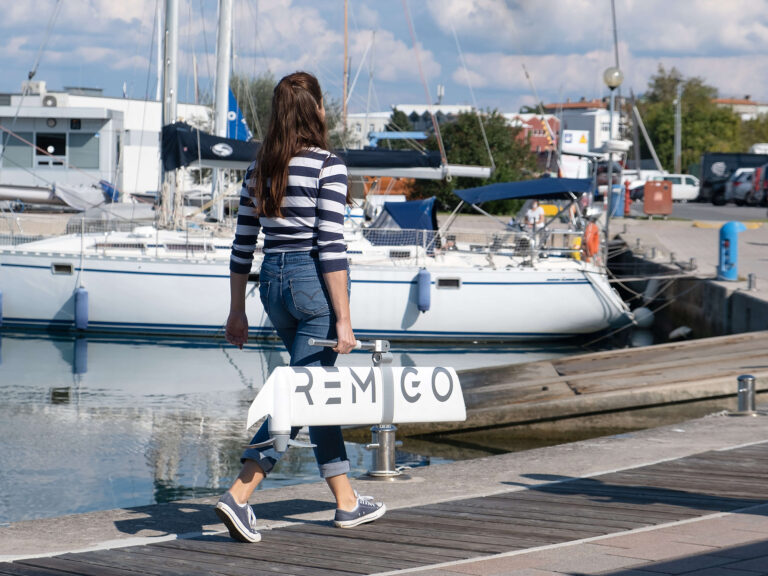While armies on land struggle through the proverbial “fog of war,” we sailors at sea struggle with the “war of fog.” The salient feature in both situations is uncertainty, and when that misty shroud descends upon us, safe navigation becomes decidedly less certain. That is, unless we have armed ourselves with a prior understanding of the phenomenon and the equipment with which to combat it.
The principal rule of war is “Know thy enemy.” Similarly, to best shape our strategies, it behooves us to have a deep understanding of what causes fog; where and when it’s most likely to occur; and what characteristics we can expect of it, such as density and duration.
The National Weather Service defines fog as “a low-lying cloud that touches land or water and reduces visibility to less than one kilometer (3,220 feet).” There are multiple reasons this phenomenon may occur, resulting in six types of fog, five of which affect the mariner.
Generally, fog occurs when the air is cooled below its dew point, or the dew point is raised to the air temperature through the addition of water vapor (see “A Glossary for Fog,” below). This tends to happen on or close to terra firma because landmasses gain and lose heat faster than large bodies of water. Thus, navigable rivers, estuaries and coastal areas, while not necessarily the cause of fog, are often the inadvertent recipients.
On the West Coast of the United States, fog is endemic from the Straits of Juan de Fuca south to Santa Barbara, California. On the East Coast it occurs from the Canadian Maritimes south to Long Island Sound. On average, these regions experience fog 10 percent of the year, with certain pockets, such as Maine and northern California, recording daytime fog more than 20 percent of the time. However, depending on location, there are seasonal variables. North of Santa Barbara, more than half the foggy days occur in July and August. But south of that latitude, most fog appears from September to February.
Types of Fog
The most common type is called radiation fog. It forms at night when the local air mass is stable, the skies are clear (resulting in rapid loss of heat from the land), and the layer of air above is at a higher temperature. When this confluence of conditions occurs, the morning’s winds become relevant. If the breeze is dead calm, the fog will rise to only 2 to 4 feet above the sea surface, presenting little challenge to navigation. But as the winds increase to a mere 5 knots, mixing the layers of air, fog can rise up hundreds of feet to obscure the waters ahead and obstruct reference points on land. This water-laden blanket is heavier than the surrounding air and tends to drain out of low-lying basins, valleys and river mouths; thus, with knowledge of local topography, one might accurately predict areas of exacerbated trouble. One fortunate characteristic of this type of fog is that it tends to “burn off” as the sun rises. But if one plans to wait out the fog, it must be noted that the farther from land one ventures, the slower the burn off.
Advection fog can be more troublesome to predict (or avoid) as it can occur day or night, in any season, and often far out to sea. This fog is caused by winds carrying warm, moist air over colder water, and can be either an onshore breeze delivering warmer air from the open ocean toward the colder coastal waters, or warm air flowing over cold oceanic streams such as the Peruvian or California currents. This becomes naturally enhanced during periods of cold-water upwelling, such as the La Niña phase of the El Niño Southern Oscillation Cycle (ENSO). The resulting fog can be very dense and linger for as long as the conditions persist. Thus, unless a weather forecast predicts significant change, waiting out this type of fog is not usually a viable option.
Frontal fog occurs when rain falls through layers of air decreasing in temperatures, typical of a passing front. When the warm raindrops hit a thin layer of cold air at the ocean’s surface, some evaporation occurs. The developing mist usually dissipates as the front passes, and sailors can soon be on their way unencumbered.
Steam fog affects the trailer sailors among us, as it is mostly connected with smaller inland lakes and languid rivers. Cold air passes over shallow water made noticeably warmer during long summer days. If the winds are calm, a type of steam rises vertically from the water’s surface, much like steam rising from a hot bathtub. This occurs usually in the mornings and evenings and typically dissipates during recreational sailing hours.
For more adventurous high-latitude sailors, ice fog becomes a problem. Even though cold air is typically drier than warm air, when the temperature falls to an extreme low the moisture that remains in the air can form into ice crystals that impede visibility significantly. Only a notable rise in temperature will remedy this. The recommended strategy is to sail south until a cold beer sounds better than a hot toddy.
Safe navigation through any fog requires not only that you accurately identify your position and that of others, but also that other vessels can identify you. There are many tools available with which to ensure this, none of which are sufficient by themselves. Therefore, do not define what a piece of equipment can do, but what it cannot do. For example, a GPS may tell you where you are, but it does not tell you where the other vessels are.
“AIS, man. Just get AIS!” one sailor advised me.
But AIS does not notify you of an approaching vessel unless that vessel is also integrated into the system. I think prudent mariners should utilize every tool available within their budget, ranging from the simplest and most reliable to the more sophisticated.
Rules of Engagement
Rule 1: Be Seen. I emphasize the defensive approach first because, as Sancho Panza said in Don Quixote, “Whether the rock hits the pitcher, or the pitcher hits the rock, it is still very bad for the pitcher.” Mount a durable radar reflector high in the rigging. Via VHF radio, question passing ships consistently as to the quality of your radar reflection on all angles and degrees of heel. Do not assume that nearby vessels are equipped with all the “modern conveniences” of navigation. Carry an old -fashioned foghorn, the simplest and most dependable way of announcing your presence. If entering a constricted area known to carry heavy marine traffic, do not hesitate to use the “Security, Security, Security” protocol on your VHF radio to announce your position, course and speed. If your home waters or intended cruising grounds have a reputation for endemic fog, by all means upgrade your equipment to an AIS transponder. But do not relax your vigilance for having done so.
Rule 2: See. While AIS receivers alert you to those vessels participating in the system, radar will cover most of the vessels that are not. However, when operating in crowded waters strewn with a confusion of fixed and moving targets, it is difficult to discern which ones present a clear and present danger. Pay more attention to the vessels in front of you and forward of the beam. This is not because you are claiming right of way on the overtaking (and therefore burdened) vessels behind you, but because the closing speeds are far greater when the approach is on reciprocal courses. If you decide to alter course to avoid an oncoming vessel, choose the starboard turn whenever possible. Be decisive. Do not alter course often and erratically, because vessels that do have you on their screen will not know how best to avoid collision. In that vein, do not trail fishing lines, pole out headsails or configure the rig in any way that prevents a rapid evasive maneuver.
Remember, many vessels, due to their shape, and hull and spar materials, do not present reliable radar targets. Even those that do, depending on the installation height of your radar, can be so close as to fall beneath the narrow radar beam into what might be called the blind zone.
Rule 3: Slow down. This simple tactic reduces closing speeds, creating more time for that evasive maneuver and reducing the ultimate consequence of any collision.
Rule 4: Listen. The human ear can audio-locate to within 1 degree of accuracy if the sound comes from ahead, and 15 degrees if it comes from the side or behind. The moisture in fog increases the density of the air; thus sound carries to a surprising degree. Additionally, the same thermo layers often associated with fog can reflect sound waves — that otherwise would have escaped into the atmosphere — back down to the water’s surface. The soft hum of the inboard engine on that little wooden launch — the launch all the other tools or tactics have missed — will tell you all you need to know. Even those human voices in the engineless sailboat ghosting past will be discernable, that is if your engine is not roaring, the stereo isn’t blasting and the iPod headphones aren’t in your ears.
Adapt your watch-keeping habits to the situation. On our 14-day passage from Northern Japan to the outlying Aleutian island of Attu, we never once saw beyond our pulpit. Our normal habit of scanning the horizon every 20 minutes was rendered useless. Instead, we turned up the VHF so it could be easily heard from the cockpit; announced our presence at regular intervals via VHF and foghorn; and listened more than we watched, because the rumble of a tanker’s engine can be detected through your own hull from many miles away. We even sniffed the air for the presence of diesel exhaust. (I say we, but actually my wife, Diana, may well have been a drug dog in a previous life, for her olfactory senses are so highly tuned that she has, on several occasions, detected the presence of a ship long before it appeared on even a clear horizon.)
In summary, know the types of fog you are most likely to encounter in your chosen cruising area. Carry and familiarize yourself with all the tools you can afford. See and be seen. Stop, look and listen. And then go forth confidently into the mist, for it so often occurs in some of the most beautiful areas of our world, and in its own way adds a textured beauty to our nautical landscape.
A GLOSSARY FOR FOG
AIS (Automatic Identification System): There are three categories: Class A is a transponder (it transmits and receives information) using 12 watts of power. Required by law on ships of 300 tons or more on international voyages, and 500 tons or more domestically. All passenger ships are required to carry a Class A AIS. Class B is voluntary and mostly used for recreational purposes. Transmits and receives using 2 watts of power. Class C is voluntary and receives information only.
Dew point: The temperature below which water vapor in air at a constant barometric pressure condenses into water.
Condensation: A reduction to a denser form, such as steam to water.
Evaporation: The process through which a liquid turns into a vapor without reaching its boiling temperature.
Relative humidity: The amount of water vapor in the air divided by the amount of water vapor that would be present if air of the same temperature and pressure were saturated. This is expressed as a percentage.
Saturation: The point at which air cannot absorb more moisture. The higher the temperature of the air, the more water vapor it can absorb.
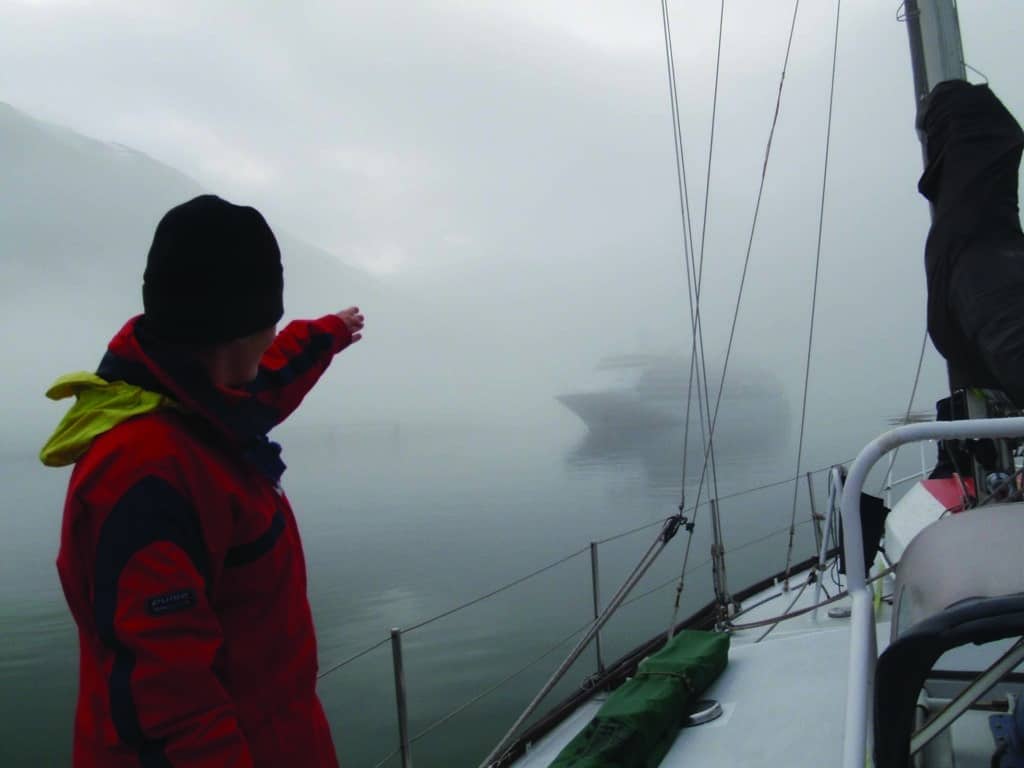
Sailing in Fog
